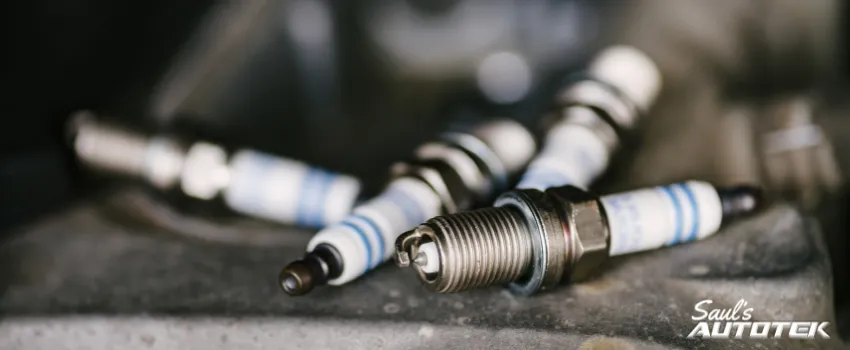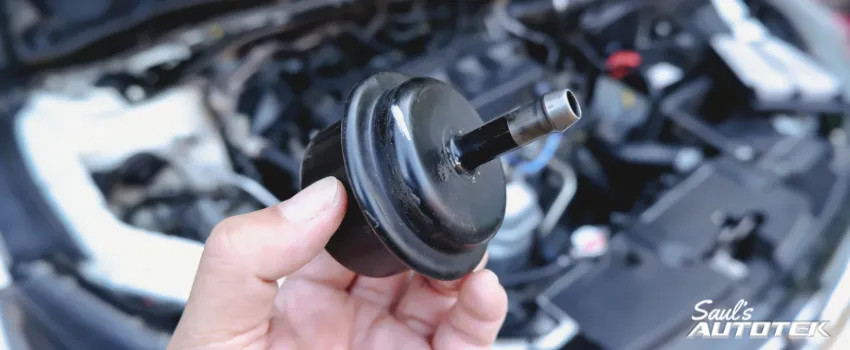Good morning. This is Saul here at Saul’s Automotive.
Read Part One Of Our Suspension Series Bushing Here
The next step in the front end of your suspension that we’re going to be looking at today is what we call the tie rod, what many people often refer to as the tire rod. The correct terminology is tie, T-I-E, as this rod physically ties the steering knuckles to the center of the vehicle.
When your vehicle is driving down the road, we have a center mechanism, often referred to as a center link or as the rack and pinion, depending on the style of vehicle you’re driving. We’ll talk more about that later. That pivots side to side to physically push the wheels as you steer. There’s a total of four joints in this system.
The first we are going to look at is in my right hand. Where my right wrist is is our outer tie rod end. As I steer side to side to pivot, where this rod end is attached into the knuckle of the vehicle, it must push and pull accordingly. When that happens, because the knuckle must tow in and out, this joint must physically rotate. This can’t just be a bolt, tight and snug. To keep that motion smooth and fluid, we will take a look at how these joints are actually built.
First one we see when we take this castellated nut off, there’s a hole from the factory drilled through. That matches this nut, so that after these are installed and torqued, a safety pin, often known as a cotter pin or, in a racing situation, safety wire, can be threaded through, so that in the event that the joint fails, it physically cannot separate, which would result in a loss of steering, a very unsafe situation.
The next part we have on is the boot. The goal of this guy is simply to keep grease packed into this joint nice and tight. When this joint is installed, this boot will be pressed to a height of less than an eighth of an inch, and it will circumference over one hemisphere of this joint, truly securing grease into it.
If we look inside the joint itself, we can actually see a ball and socket. This is just like your shoulder’s rotator cuff. This outer housing is physically wedged and forged around a steel ball stud. This is a metal to metal joint filled with grease. Because it is metal to metal, every time it pivots and rotates back and forth, grease gets moved through this joint. This generates heat over time, which eventually leads to boot failure, grease failure and then the joint itself will heat up, become case hardened, which will actually shrink the metal a minuscule amount and will result in this ball stud being able to pivot and shake within this housing. That is when the joint is completely and totally failed.
To prevent this from happening, we have several steps in the way. First, we have the cotter pin and nut to keep it from separating if it did fail. We then have the boot to protect the grease and keep the grease into the joint. And then last but not least, on all the joints installed at Saul’s Automotive have a threaded Zerk grease fitting onto the back of them, so that every joint can be re-lubricated as long as the vehicle is in service.
What this means is rather than letting this grease get hot in here, eventually, burn up and leak out, every time you get a lube, oil, and filter, the L-O-F that grandpa told you about in the ‘60s, you should still be doin’ today, and that will protect these joints. When you go to many common chain oil change locations, these are not serviced. You need to specifically ask to have all of the joints lubricated in your vehicle.
The only vehicles that came from the factory with these kind of Zerk or greasable joint fittings are three-quarter-ton and larger trucks because those were the heaviest service vehicles on the road in the mid-‘90s, early 2000s in production. Because the cost of these components from a manufacturer’s standpoint can be so much higher, here at Saul’s Automotive, we don’t see these in everyday cars. We put them in every car that leaves, so that no matter what, if you have a steering or suspension joint replaced here at Saul’s Automotive, we can grease it for the life of the vehicle.
That’s part of why we’re able to offer a lifetime guarantee, parts and labor, nationwide on any steering and suspension component installed. Period. We can guarantee that as long as these are greased and maintained, it will literally never fail.
If you have steering components that are starting to wear out, starting to get loose, starting to feel like grandpa’s truck, come and see us. We can take care of these. We can not only fix it, make it tighter than it was from the factory, but we can also guarantee it stays that way and doesn’t slowly become the same loose truck or loose car it was before.
If you have any concerns about your steering, suspension or any of the components involved, please come and see us here at Saul’s Automotive. We can be reached 365 days a year at 303-919-7769.
Schedule Your FREE diagnostic Subaru Outback Auto Repair Upkeep and Repair Appointment
Check out Our Reviews On Yelp! And Leave A Great One For Us!
Join Our Conversation on Facebook
Explore Our Exceptional Denver Auto Repair Services
- Brake Repair Service
- Suspension Repair
- Steering Repair
- Engine Repair
- Automotive Air Conditioning and Heating Repair





